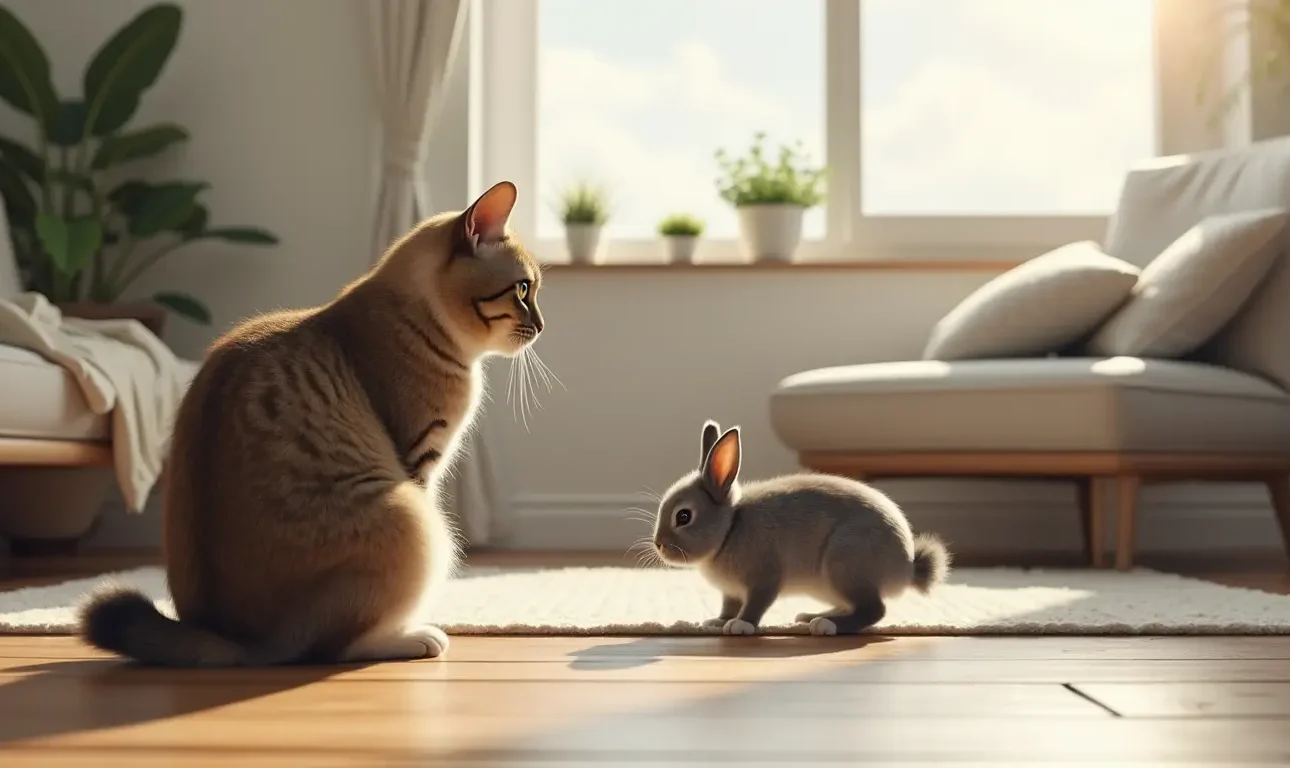Have you ever wondered what it would be like to have a cat and bunny as your companions? Imagine the soft purrs of your cat and the gentle hops of your bunny, coexisting peacefully in your home. While it might sound like an idyllic situation, many pet owners are curious about how well cats and bunnies can truly get along. After all, they are different species with unique behaviors and needs. Can they share a space without causing chaos?
In this guide, we’ll explore everything you need to know about living with both a cat and a bunny. From understanding their personalities to providing the right environment for them to thrive together, we’ll give you the tools you need to ensure a peaceful, happy home for your furry friends.
Table of Contents
- Introduction: Can Cats and Bunnies Get Along?
- The Temperament of Cats and Bunnies
- Can a Cat and Bunny Be Friends?
- How to Introduce a Cat and a Bunny
- Creating a Safe and Comfortable Home for Both
- Feeding and Caring for a Cat and a Bunny Together
- Signs That Your Cat and Bunny Are Not Getting Along
- FAQ
- Conclusion
Introduction: Can Cats and Bunnies Get Along?
When you bring home a cat and a bunny, the first question that might cross your mind is, “Can these two animals coexist peacefully?” It’s a valid concern—after all, cats are known for their hunting instincts, while rabbits can be timid and flighty. But fear not! With the right approach, a cat and bunny can form a surprisingly harmonious relationship.
Before we dive into the details, let’s take a moment to think about your current pets and their personalities. Do you have a cat who loves attention but isn’t overly aggressive? And a bunny who’s calm and confident? Then you may already be one step closer to having a successful pet duo!
Let’s explore how you can introduce your cat and bunny to each other, create a safe environment, and ensure that both animals are comfortable and happy living together.
The Temperament of Cats and Bunnies
Understanding the temperament of each animal is essential before attempting to bring them together. While both are incredibly popular pets, they have very different needs and behaviors.
Cats
Cats are independent, territorial animals. They love to explore and may sometimes be more aloof, but they’re also affectionate when they choose to be. Some cats, especially those with high prey drives, may view smaller animals, like bunnies, as something to chase. However, not all cats will exhibit this instinct, and many can learn to coexist peacefully with other pets.
Bunnies
On the other hand, rabbits are prey animals. They tend to be more timid and easily startled. Unlike cats, bunnies thrive in calm environments and need space to hop around and feel secure. A bunny’s natural instinct is to run and hide when they feel threatened, so it’s crucial to create a safe space where they can retreat if needed.
Can a Cat and Bunny Be Friends?
So, do cats and bunnies get along? The answer is, it depends! While cats and bunnies can absolutely live together, the relationship depends on the personalities of both animals and how you introduce them.
Some cats and bunnies form beautiful bonds, sharing space and even interacting with each other. However, there are cases where cats may display predatory behavior, and bunnies may get stressed or fearful. The key is gradual introductions and careful supervision during the initial stages of their relationship.
Factors That Influence Their Relationship:
- Age and Temperament: Older, calmer cats tend to get along better with bunnies. High-energy kittens may be too much for a rabbit to handle.
- Prey Drive: Cats with a strong prey drive might have difficulty accepting a bunny, while others are more indifferent to small animals.
- Past Experiences: If a cat has been exposed to other animals, they might be more tolerant of a rabbit.
Real-Life Example: Take Sarah, for example, who adopted both a kitten and a bunny at the same time. She was concerned about her kitten’s tendency to chase moving objects. But after a careful introduction and lots of patience, Sarah found that her cat, Luna, and her bunny, Thumper, could peacefully coexist. Luna would occasionally watch Thumper from a distance, but she never chased him. Thumper, on the other hand, would hop around Luna without any fear!
How to Introduce a Cat and a Bunny
The key to a successful cat and bunny relationship is the introduction process. It’s essential to go slowly and carefully to ensure that both animals feel safe and comfortable.
Step-by-Step Guide:
- Keep Them Separated at First: Begin by keeping your cat and bunny in separate rooms. Let them get used to each other’s scent by swapping bedding or using a cloth to rub both animals, allowing them to smell each other.
- Supervised Meetings: After a few days of scent swapping, allow them to meet face-to-face in a controlled environment. Keep the cat on a leash or in a carrier and let the bunny roam freely. This ensures that the cat cannot chase the bunny if they get too excited.
- Observe Their Reactions: Watch closely for signs of aggression or stress. If the cat is showing signs of predatory behavior (staring, crouching), immediately separate them and try again later.
- Gradual Exposure: Over time, allow them to interact more freely, but always supervise. Some animals take longer to adjust than others.
Creating a Safe and Comfortable Home for Both
Once your cat and bunny have become accustomed to each other, it’s time to focus on creating a safe, comfortable living space for both. Here’s how you can do that:
- Separate Spaces: Make sure your bunny has a designated area where they feel secure, like a bunny-proofed room or a large cage. Cats may try to invade this space, so it’s crucial to have boundaries.
- Elevated Spaces for the Cat: Cats love high places. Provide your cat with shelves or a cat tree to give them a vantage point where they can observe the bunny from above, without feeling the need to pounce.
- Safe Zones for the Bunny: Rabbits need a place to retreat if they feel threatened. Make sure your bunny has a cozy hideaway where they can relax undisturbed.
Feeding and Caring for a Cat and a Bunny Together
Feeding time can be a potential area of conflict, so it’s essential to keep their diets separate. Cats are obligate carnivores, meaning they need meat-based food, while rabbits are herbivores with a diet focused on hay, vegetables, and pellets.
Make sure each pet has its own feeding station, and supervise meal times to prevent any disputes. It’s also important to maintain a proper routine for both pets, ensuring they each get the attention and care they need.
Signs That Your Cat and Bunny Are Not Getting Along
While most cats and bunnies can coexist peacefully, there are signs that indicate things aren’t going as smoothly as you’d like. Look out for:
- Hissing or Growling: If your cat is hissing or growling at the bunny, it could indicate a territorial issue.
- Aggressive Staring: Intense, focused staring from the cat could signal a predatory instinct.
- Bunny Stress: If your bunny seems anxious or fearful around the cat, it’s a sign they may not feel safe.
If you notice any of these signs, it may be time to reassess the living arrangement or seek advice from a professional animal behaviorist.
FAQ
1. Can a cat and bunny live in the same room?
Yes, with proper introductions and supervision, cats and bunnies can live in the same room. However, it’s important to ensure the bunny has a safe space to retreat to.
2. How do I stop my cat from chasing my bunny?
Make sure your cat has enough stimulation through play and exercise, so they don’t focus on the bunny. Gradual introductions and positive reinforcement can also help reduce chasing behavior.
3. Should I get a kitten or an adult cat to live with a bunny?
An adult cat with a calm temperament is generally a better choice for a bunny. Kittens have high energy and may be more likely to view the bunny as a plaything.
Conclusion
Bringing a cat and bunny into your home can be a rewarding experience, but it requires patience, understanding, and careful planning. By considering their individual temperaments, providing a safe environment, and supervising their interactions, you can ensure that both your cat and bunny thrive together. Whether they become best friends or simply coexist peacefully, the bond between these two pets can be one of the most rewarding relationships to witness.
Remember, each animal is unique, and the key is to take things slow and respect their individual needs. If you follow these guidelines, you’ll be well on your way to a happy home with both a cat and a bunny.






